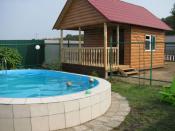Search
Login
We agree on the dismantling of partitions, the creation of openings in partitions enclosing gasified rooms
The cheapest and most common ways of heating country houses are systems with natural gas boilers. It has a very affordable cost, it is easy to transport - centralized supplies of blue fuel are carried out in almost all settlements. But the use of gas for the operation of stoves and heating boilers requires a responsible attitude of consumers - gas belongs to the category of explosive substances and a careless attitude to equipment and violation of the rules for its operation can cause a fire.
Content:
- Gas Requirements
- Work that can be carried out during the reconstruction of gasified premises video
- The procedure for the conversion and redevelopment of premises in residential buildings
- What types of work and actions are unacceptable when performing redevelopment
Gas Requirements

The installation of gas boilers, and the premises for their installation, are subject to special requirements. If they cannot be satisfied, then the gas service has the right to refuse to connect a new user to the trunk. Such a tough statement of the question is not a tribute to the bureaucracy, the reason lies in the presence of very sad experience and in the increased fire hazard of gas-fired plants. The list of requirements concerns not only the quality of the devices and the correct installation, but also the parameters of the room in which it is planned to install the boiler and stove.

The requirements for the installation of gas heating equipment are as follows:
- ceiling height should be greater than 2.5 m,
- the room itself must have an area of \u200b\u200bat least 4 square meters,
- the door leading in must have a width of not less than 0.6m,
- the room should be naturally lit, i.e. have a window, and for every 10 sq.m. must have at least 0.3 sq. m of window opening.
The premises must be well ventilated, only in the event of an influx of sufficient oxygen there will be a complete combustion of gas in the boiler. The air flow should be provided through an opening with an area of \u200b\u200bat least 8 sq. Cm for each 1 kW of heating device power.
Pipes during installation use only metal, flexible hoses are suitable for connecting gas-consuming devices. Depending on the power of the gas heater, the diameter of the chimney is calculated. When performing installation work, it is necessary to observe the correspondence of the cross-sectional area of \u200b\u200bthe chimney to the area of \u200b\u200bthe hole for its connection. The chimney under construction must rise at least 0.5 m above the roof.

The boiler’s power supply system is equipped with an automatic machine with configured current and thermal protection, in the same room as the boiler, a gas analyzer is installed. To place gas equipment, you can use the basement only if the house is private and belongs to one owner. Each unit of installed gas equipment is equipped with a meter. For the arrangement of ventilation use the upper part of the room.
More complete information about the requirements can be obtained from the norms of SNiP and the Code of Rules for the design of autonomous heating systems.
Work that can be carried out during the reconstruction of gasified premises

It should be noted that any reconstruction measures, whether moving old appliances or installing new ones, requiring the installation of additional networks, dismantling walls or partitions in gasified rooms, require coordination with the gas service.
If it is planned to equip additional openings in the partitions that serve to enclose gasified rooms, then the regulations provide for the obligatory arrangement of a door unit that complies with technical standards.

It is forbidden to equip openings in load-bearing structures (walls) before examining their technical condition and obtaining an opinion on the possibility of carrying out the relevant work, which is allowed after the development of project documentation.
The project will also be required if homeowners plan to close up previously made openings in the walls (bearing) or ceilings. The development of the project begins after receiving a conclusion that, as a result of a technical examination, a conclusion was made on the inadmissibility of maintaining openings in supporting structures, or simply in connection with the desire of the owner of the housing to eliminate openings not included in the project.
The procedure for the conversion and redevelopment of premises in residential buildings

The procedure for performing such work is strictly regulated by special regulations. A decision on redevelopment should be made only after studying the list of acceptable types of work, taking into account that the planned activities will require coordination and development of project documentation, you should also familiarize yourself with the list of works that are prohibited according to the standards. For example, the dismantling of partitions that are not load-bearing, as well as from the construction, can be carried out without drawing up a project, but after completion of the work, an act on the completed reconstruction will be required, it is compiled on the basis of the owner’s appeal to the housing inspection.
In the case of work that will require the preparation of the project, an initial survey of the object is carried out, after analyzing its condition, an opinion is issued on its technical condition and on the possibility of carrying out reconstruction works in it. The development of the Technical Conclusion is carried out by the design organization, the author of the building project, if it is absent, then any design organization of the appropriate rank.
Further, in the case of a positive research result, a project is developed. Any of the design organizations having access to this type of work can carry out its development; the right to choose it remains with the owner of the housing. Based on the above documents, an agreement is made on the conversion or redevelopment. The final stage is the drafting of the Act on the completed reconstruction, they are made up after the completion of work. After receiving the Act, it is handed over to the BTI, where changes are made to the relevant technical documentation.
What types of work and actions are unacceptable when performing redevelopment

There are also a number of activities that are strictly prohibited during the redevelopment of premises.
- First of all, this concerns work that can lead to a deterioration in the operating conditions of the structure, cause inconvenience for those living in the house, and become an obstacle to access to heating and ventilation systems.
- Planned work should not lead to a violation of the stability of structures or cause their destruction, in particular this item refers to the device of the opening in the partition or wall that is the carrier.
- It is especially important not to upset the section of the natural ventilation channels, which is very important for gasified rooms. Cases of violation of fire safety requirements cannot be allowed.
It is strictly forbidden to carry out any redevelopment and reconstruction work in houses that are considered emergency.





